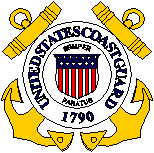The Sinking of the USCGC MAGNOLIA
WAGL-231
24 August 1945
by
Lieutenant Colonel Ted Allan Morris, USAF,
Retired

The "Maggie" was rammed amidships and sunk by the SS
MARGUERITE LE HAND, a brand new 18,000-ton type
C-3 cargo vessel on its maiden voyage. The MARGUERITE
LE HAND was named posthumously for President
Franklin Roosevelt's private secretary of 21
years.
The MAGNOLIA had just cleared the sea buoy in
the Gulf of Mexico preparing to enter Mobile Bay.
The time was 2328 hours, 24 August 1945.
The MAGNOLIA and the MARGUERITE LE HAND
had exchanged one blast of the whistle signaling for a
port to port passing when the MARGUERITE LE HAND
came hard aport. The Magnolia went hard
astarboard in an attempt to avoid collision and was
rammed amidships, the bow of the MARGUERITE LE
HAND slicing deep into her port side.
Almost immediately, the MARGUERITE LE HAND
reversed its engine and backed out, leaving a gaping
hole in the MAGNOLIA'S hull nearly to the
keel. Having virtually no watertight
compartments, the Gulf of Mexico poured in and the MAGNOLIA
sank in less than two minutes.
Fifty-nine crew members survived primarily because
the night was exceptionally hot. The ship had
practically no ventilation into the lower crew
quarters, so the majority of the men had gone topside
to sleep wherever they-could find a level spot.
One man was lost in the sinking.
The MAGNOLIA was unable to launch life
boats. She carried a 26 ft. motor launch and a
26 ft. pulling boat, plus several life rafts.
The pulling boat was smashed when someone on the MARGUERITE
LE HAND released a 15 ton slide-mounted life
raft onto the MAGNOLIA at almost the moment
of the ramming impact. Most-crew members did not
have time to don life jackets and had to spend several
hours treading water to stay alive.
The MARGUERITE LE HAND
launched several life boats, searching for and picking
up survivors. The MAGNOLIA
used a very thick bunker IC fuel oil and the majority
of survivors were coated with it. Many of us
swallowed quantities of the foul stuff requiring
hospital treatment after being landed in Mobile.
Built in 1904 at Baltimore, MD, for the US Light
House Service, the MAGNOLIA was
173 feet long with twin reciprocating steam engines
driving twin screws. The Coast Guard inherited
the Light House Service and the MAGNOLIA
in 1939. Part of the "Flower Fleet" of ships,
she performed the hard, dirty job of maintaining aids
to navigation of all types, from lighthouses to buoys.
Shortly after the collision many of the MAGNOLIA'S
crew went to Norfolk, Virginia, to man the CGC SALVIA,
WAGL-400 (then Arelatively new 180 ft. buoy tender),
bringing her to Mobile to replace the MAGNOLIA.
Albeit while the MAGNOLIA was
not sunk by enemy action, it was the last major Coast
Guard ship sunk during World War II and as the
survivors would attest, the water was deep, oily, very
wet....and the night very long waiting to be rescued.
As an 18 year old S 1/C (QM) with 18 months service,
I was the youngest crew member on board the MAGNOLIA
when she was rammed and sunk on 24 August 1945 during
the final days of World War II. Following the MAGNOLIA
incident, I went into Coast Guard Aviation serving
another three years as an Aviation Machinist Mate.
|